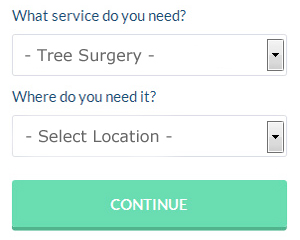Barton-upon-Humber Tree Surgeons (DN18): Producing essential oxygen for our environment, providing home and shelter for our ever decreasing wildlife and offering havens of shade on hot summers days, trees are awesome things to have and enjoy in our gardens. But there are several drawbacks; trees can get damaged by storms and wind, trees can get diseased and unhealthy or trees can become too huge for our gardens in Barton-upon-Humber. The best person to call when you have problems with your trees in Barton-upon-Humber, is a tree surgeon.
For a multitude of customers in Barton-upon-Humber - both commercial and domestic, tree surgeons provide a key service in the maintenance and general care of trees. There are countless examples of services that a tree surgeon in Barton-upon-Humber will be able to provide: the safe planting of trees, felling, inspections and hazard assessments, the pruning of weak, dead or intruding branches, along with general tree care.
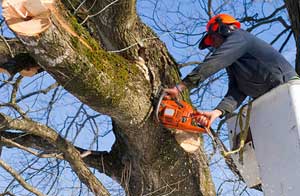
However, it's not simply trees that float a tree surgeon's boat! Such tasks as stump removal, hedge trimming, care and maintenance, are among the additional duties of a tree surgeon in Barton-upon-Humber. If you've got any worries about a tree's structural integrity, the best person to contact is a tree surgeon, as they can easily assess and prepare a full report on potential hazards, and offer guidance on what should be done next.
Any intelligent person in Barton-upon-Humber would understand that tree surgery is an exceptionally hazardous occupation, and that it should not be attempted by somebody that is not properly trained. Though the temptation could be to go for a do-it-yourself approach and avoid the costs, it probably wouldn't be the wisest decision you've ever made. So as to undertake this type of task, tree surgeons have to be experienced, physically fit and qualified.
Tree surgery often involves the use of dangerous power tools while high up in the air and harnessed to a tree. This is certainly not a task for a novice! To accomplish a tree surgery project, a gang of tree surgeons all specialists at what they do, will usually be involved, and this should consist of both a ground team and climbers. Rivalling this level of competence, risk assessment and experience to complete the work, would be nigh on impossible for any unqualified individual.

The first step following establishing that you need the assistance of a tree surgeon is locating a decent one in Barton-upon-Humber. But, how can you accomplish this? Well, you'll need to check out a number of things, such as experience, cost and qualifications. Next we will cover a few things you should look for when choosing a tree surgeon in Barton-upon-Humber.
To reassure you they are properly trained and competent, you first of all need to ensure that they've got the appropriate certifications. The governing body that issues qualifications to tree surgeons is the National Proficiency Tests Council (NPTC). Any Barton-upon-Humber tree surgeon should have the following certifications at the very minimum:
- NPTC 203 (CS31) - Fell & process trees up to 380mm (15 inches).
- NPTC 206/306 (CS38) - Climb a tree and perform aerial rescue.
- NPTC 201/202 (CS30) - Basic crosscutting and chainsaw maintenance.
- NPTC 308 (CS39) - Operate a chainsaw from rope & harness.
Although tree surgeons aren't legally obligated to have these certifications, it's certainly worth asking for them, as they show that they have the proper training to both complete the task safely and successfully. Tree surgeons, forestry workers and arborists should also carry a comprehensive First Aid kit and have some First Aid qualifications, due to the risks of catastrophic bleeding and falling from height.
Next, check the breakdown of the costs and ask three or four tree surgeons in Barton-upon-Humber to obtain different quotes for the work. Quite often, the estimated cost won't include the disposal of the considerable amount of waste often generated by tree surgery. It's definitely better to get the tree surgeons to remove this waste themselves if you can, as getting rid of such waste can be exceptionally inconvenient and costly.
In addition to this, make sure you are ready to ask a number of important questions when you meet with the tree surgeon. You will, for example, want to know precisely who is going to be doing the actual work. Is meeting them before they start a possibility? Will it be just one individual working on their own, or will it be a whole crew of workers? Precisely how long will the work take? Is there going to be any impact of my home or next door neighbours? What will be the method for removing your tree?
If you ask all the appropriate questions, you're less likely to get any nasty surprises later on.
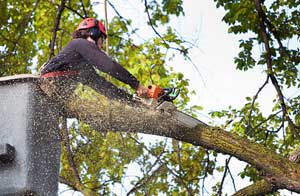
Also, listen to how your tree surgeon speaks and what they say. Listening to how they describe the work can give you an inkling of their levels of expertise and professionalism. Even if you know hardly anything about tree surgery yourself, you can usually tell when someone knows what they're talking about, and the kind of terminology that should set the alarm bells ringing is 'topping and lopping', which is a rather outdated phrase, more closely associated with rogue traders and cowboys. More appropriate terminology like 'pruning', 'crown reduction', 'crown lifting', 'dead wooding' and 'thinning', will trip off the tongue of a tree surgeon in Barton-upon-Humber who is experienced, fully trained and professional. While this can be a useful clue with regards to the level of expertise attained by your tree surgeon, it's not necessarily evidence of ability.
To conclude, it's always worth consulting a variety of tree surgeons in Barton-upon-Humber in relation to any potential tree surgery or tree maintenance requirements you may have. This should help you to find the best individual for the job, and one that will ensure all your needs are fully catered to in a pre-agreed timeframe, and with safe practice at the forefront of their mind.
Local Barton-upon-Humber tree surgery services are most likely have the telephone code 01652 and the postcode DN18. They'll operate in Barton-upon-Humber itself, as well as nearby areas like Winterton, Burton upon Strather, Barnetby-le-Wold, South Killingholme, Barrow-upon-Humber, Immingham, South Ferriby, Winteringham, Ulceby, Appleby, Hessle, Goxhill, and these postcodes: DN18 5NR, DN18 5HB, DN18 5PL, DN18 5AS, DN18 5FQ, DN18 5DG, DN18 5AT, DN18 5DH, DN18 5EU, DN18 5BY. Checking this should confirm you're accessing a local tree surgeon. Barton-upon-Humber householders are able to utilise these and numerous other similar services.
If you require this sort of service it is certainly far better to use a trusted tree surgeon. Barton-upon-Humber property owners can substantially benefit from the skills that are the trademark of a trained professional.
Removing Tree Stumps Barton-upon-Humber
When you have a tree cut down and removed from your garden in Barton-upon-Humber, unless agreed with the tree surgeon, you'll likely be left with a stump to contend with. You might be thinking about using the stump as a quirky garden seat for example, and might be happy to leave it in position until it eventually rots away. However, a large tree stump could take a number of years to rot down, and could even send out suckers in an effort to restore itself to its former glory. Protruding tree stumps can also be a trip hazard, an eysore and can attract harmful pests.
Stump grinding and stump removal are the two main alternatives, if you do opt to get rid of the tree stump once and for all. Purely for the purposes of this piece we will be looking at removal as opposed to stump grinding.
Burning, chemical treatments or digging out by hand, are the 3 main methods of removing a tree stump. If you wish to take a shot at tree stump removal yourself, you could choose any of these techniques when suitable. If a tree surgeon is going to be undertaking the work, stump grinding is typically their technique of choice, although eco-plugging or another chemical removal treatment might also be considered.
Digging Out a Stump by Hand: Digging up a tree stump by hand will require an assortment of tools such as a pointed spade, a chainsaw, loppers and a handsaw. It involves digging down to expose the roots, chopping the roots with loppers or saws, and finally releasing the stump, to make it easier to lift out. You might need to use a winch for the final lifting out of the tree stump. This is hard work and isn't for the faint-hearted or unfit.
Tree Stump Burning: As it can be dangerous and could contravene local laws, burning stumps is not really recommended, so if you choose this technique, take care. It comprises drilling a few holes in the tree stump and continuously filling the holes with vegetable oil and left to sit for aa few days. Charcoal is then heaped around the stump and set alight. However, this must be monitored continually and never left unwatched. Once the burning process has finished, you should make sure that the fire is fully extinguished, and when it has completely cooled down you can dig out and clear away the charred remnants of roots and stump.
This isn't the only method of burning a tree stump, and you could also try digging out all the soil from beneath the stump and setting a fire in the cavity that has been made underneath. Of course, there are various situations where stump burning is not suitable, such as when there are a building, fences or other trees close to the stump in question.
Chemical Stump Removal: The chemical treatment option calls for the use of a powerful chemical substance for example Vitax SBK Stump Killer, Resolva Xtra Tough Tree Stump Killer or Roundup Tree Stump Remover. It is vital that you closely follow the directions when applying any of these chemical substances, because they can be extremely dangerous and toxic. Subject to the dimensions of your stump, and whether it is alive or dead when it is treated, it can take quite a few weeks or even months for a tree stump to rot down completely, so regard this as a long term rather than a short term fix. Once well decayed, it can be chopped up with an axe and removed with a spade.
Protecting Trees & Shrubs in Winter
Although prolonged periods of extreme cold are fairly rare in the UK it's still worthwhile to think about some measures for protecting your shrubs and trees when the weather conditions turn bad. Even the trees, shrubs and plants that we usually think of as hardy, can find winter hard to get through, especially during the colder months, and they'll invariably benefit from a bit of TLC and extra protection.
Although many of your trees will have already shed their leaves by winter in Barton-upon-Humber, it is strong winds and storms that cause the biggest worry, and despite the fact that they offer less wind resistance, they may still be vulnerable to damage. If you've got a tree in your garden that appears to be weakened, or shows signs of crashing to the ground, you will want to have it inspected by a tree surgeon, who can offer advice and guidance. You can also have issues with trees due to heavy snowfall, so when weather such as this is expected, keep an eye open for possible damage. In the height of winter, your shrubs and trees may need a little protection from ice and frost. Spreading a thick layer of mulch round the stem bases will allow them to continue absorbing moisture and stop the surrounding soil from freezing.
Dead-Wooding Barton-upon-Humber
Dead-wooding (or deadwooding) is a fundamental element of tree management and care, and all experienced Barton-upon-Humber tree surgeons will undertake this procedure where needed. Where there may be a threat to pedestrians, buildings or vehicles, dead-wooding is done to carefully remove the dead and rotting branches that are likely to fall. Tree branches can die off for a variety of reasons, with a damaged root system, attack by pests, disease or light deficiency, accepted as the most common.
Even though the most frequent rationale for removing dead branches is that of safety, it's also done to benefit the tree, or for aesthetic reasons. It's possible to greatly improve a tree's health by removing damaged, dying and dead branches, an excessive number of which will attract disease and insect infestation. Dead and decaying wood also makes a tree look unattractive, and by removing all of this, you can make it look more appealing.
Only substantial dead branches will be taken out in most instances, as very little risk is presented by the small ones. However, any dead branches that are over fifty millimetres in diameter might need to be removed in locations where a tree overhangs a park, a road, a home, a public area or a garden in Barton-upon-Humber.
Skills Necessary for a Tree Surgeon in Barton-upon-Humber
- Be able to work with your hands.
- Physical skills like co-ordination and movement.
- Have patience and the ability to remain focused in stressful situations.
- Be professional and capable of completing tasks within a given period.
- Be conscious of the complexities and dangers involved in all aspects of work.
- To be able to perform basic tasks on a hand-held device or computer.
- The capacity to work alongside other people.
- Be capable of repairing, maintaining and using tools and equipment.
- Good customer skills.
- To be meticulous and pay attention to detail.
- Good knowledge of public safety and security.
Dutch Elm Disease
A fungal disease which has wiped out many millions of precious elm trees all over the British Isles during the last 50 yrs or so, Dutch Elm Disease (Ophiostoma novo-ulmi) is not quite the problem that it was previously. Spread by the elm bark beetle (especially the Scolytus genus) and caused by a fungus called Ophiostoma novo-ulmi, DED (Dutch Elm Disease) was accidentally introduced into the United Kingdom from Canada in the 1960's.
Its fast spread was mostly down to to elm products such as mulching bark, saplings, crates, and firewood logs with the bark on, being moved around Britain. This dreadful disease didn't just affect elms in the United Kingdom, but also destroyed elm stocks in continental Europe and North America. Although the origins of DED are as yet unknown, the suspicion is that it first originated in Asia (possibly Japan).
Generally first showing up in early summer, the recognisable symptoms of DED disease are:
- Twigs that turn into a "shepherd's crook" shape.
- Foliage that turns yellow, shrivels and dies.
- Dark streaks underneath the bark of twigs.
- New shoots dying back from the tips.
The chopping down of dead, dying and infected trees, has effectively removed the favourite habitat of the beetle, and over the last few years the spread of DED has been slowed down. There is now a continuing project for propagating young saplings that are resistant to DED.
If you are suspicious that you might have infected elm trees on your property in Barton-upon-Humber, you can request a diagnosis from the Tree Health Diagnostic & Advisory Service (THDAS), or get hold of your local tree surgeon for advice.
Air-Spading Barton-upon-Humber
There are various problems that could make the health of your trees a concern, however issues with a tree's root system are frequently the cause. A local Barton-upon-Humber tree surgeon may need to access the roots to check for root rot, soil compaction, or other related problems.
During the past this was quite difficult, because of the possibility of root damage in the process of digging down. To successfully break up and clear away compacted soil without damaging tree roots or utility lines, a contemporary technique that's frequently used by tree surgeons is "air spading".
The soil surrounding tree roots can sometimes become compacted by passing vehicles, building work or foot traffic, and this is recognised as having a negative impact on the general health of a tree. Because of a lack of nutrients and water, a tree can become "stressed", making it more vulnerable to attacks by diseases, pests and insects. Air spading is also good for resolving root flare problems, when the flare at the base of the tree becomes covered with soil, causing it's tissues to break down, and increasing the possibility of root rot.
The innovative air spading process involves the use of an air compressor and an air-spading tool which blows air into the soil at a speed of 1200mph, the air enters the voids in the soil and quickly breaks it up, while leaving tree roots and nearby utility lines untouched. All the soil is blown away from the roots by the powerful air flow, meaning immediate inspection and investigation can take place. A solution can then be found for any issues, and the previously compact soil replaced with a looser layer of chip mulch and fertiliser to help revitalize the tree. (Tags: Air-Spade Barton-upon-Humber, Air-Spading Barton-upon-Humber, Air-Spade Investigations Barton-upon-Humber).
Problematic Tree Roots Barton-upon-Humber
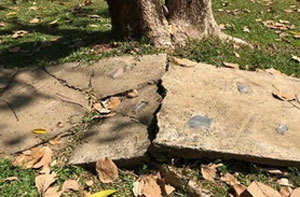
When they're growing too close to your home in Barton-upon-Humber, certain trees have really invasive root systems, and can cause problems. Among the most common problems are: lifting patios, blocked drains and damaged foundations. Species like willows, maples, sycamores and elms, are trees that have very aggressive roots.
If you're planting any new trees, make certain they're placed far enough away from patio areas, your home, paths and your sewerage system, so they do not cause serious problems in the future. If established trees are growing too near to your dwelling and are causing some of these problems, you should contact a tree surgeon in Barton-upon-Humber, to see what can be done to resolve the situation.
This isn't really the sort of task you should try to do yourself, and simply chopping off the offending roots could kill off the tree or severely affect it's overall health. To successfully survive, a tree will still need to be getting ample water and nutrients, and a skilled arborist in Barton-upon-Humber will know precisely which roots should be left, and which roots can be safely cut.
Given that sewerage pipes provide a steady source of nutrients and water, shrub and tree roots sometimes cause structural problems in underground drains. Blockages and joint failure can arise, when small tree roots grow into a drainage system's joints, establish themselves and develop into huge root balls. Specialised root removal solutions will be offered by some Barton-upon-Humber tree surgeons, who will employ manual rodding, high pressure jetting or mechanical equipment to remove the offending roots.
Tree Cable Bracing Barton-upon-Humber
Cable bracing is a procedure which is used to offer support to a tree when it shows signs of decay, damage, or is a risk to nearby property. Where it is undesirable to fell a tree or remove large, unstable sections, because the tree is old or valuable, cable bracing is an effective solution.
A cable bracing system can be installed to support V-shaped forks, weak tree limbs and defective joints. Carrying out various types of bracing work, an experienced tree care specialist will be equipped to use rods and cables to help alleviate structural stresses, and hopefully extend the life of specimen trees in Barton-upon-Humber.
Cable bracing has the goal of providing a flexible and shock-absorbing means of support which is non-invasive and does not cause further damage to the tree by drilling and bolting the branches. To guarantee the safety of the tree and adjacent areas, an extensive risk assessment must be completed before any actual cable bracing work can begin.
Stump Grinding
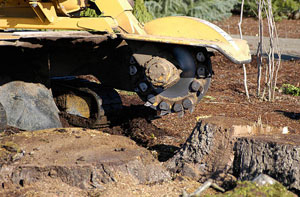
If you need to have some stump grinding done on your property, be certain to contact a company with the appropriate knowhow and gear. The finest Barton-upon-Humber tree surgeons will understand that all remnants of the stump must be removed to a depth of at least 30 cm. Grinding down stubborn roots and stumps within a few millimetres of buildings and walls while avoiding damage, can only be accomplished if your chosen tree surgeon has the use of the proper machinery. This tailor-made stump grinding apparatus is so multifaceted that it can even eradicate tree stumps that are located in alleys, passageways and other virtually hard to get at locations. If you are extracting a sizable tree the remaining stump may be fairly substantial and depending on what you are likely to use the resulting empty space for, the chances are that the stump will have to be taken out far below the surface. (Tags: Stump Grinding Barton-upon-Humber, Stump Removal Barton-upon-Humber, Tree Stump Removal Barton-upon-Humber)
Storm Damage Prevention Barton-upon-Humber
Of all the living things in our garden, trees give the impression of being the strongest, sturdiest and the most able to survive the vicissitudes of Mother Nature. Some tree species can continue to grow without any issues for hundreds (even thousands) of years, in particular sweet chestnuts, yews and oaks.
Despite all this, trees are certainly susceptible to unfavourable weather, and apart from the threat of falling branches and limbs, when faced with certain conditions trees can even fall down completely, causing untold damage or even death. High winds are a major issue for trees, and this sort of damage has become more common in Barton-upon-Humber, as the number of severe weather events and storms increases with climate change. Another problem can be heavy winter snow, and saturated soil during prolonged periods of rain or floods.
It's advisable to get a local Barton-upon-Humber tree surgeon to check out your trees to reduce the chance of problems with your trees in times of severe weather, they'll trim and remove any dead, dying or excessively long branches that could be an issue.
Lightning rods, copper conductors, or other lightning protection systems are also recommended for larger trees, to prevent them being struck by lightning and to protect nearby buildings and property which might be susceptible to side-flashes ("arcs") that can cause further damage, along with harm done to the tree itself. A tree which is struck by lightning can be killed or severely weakened, a weakened tree can be left susceptible to disease, decay or pests. Lightning occurs more frequently than you may think, and there are around 300,000 lightning strikes each year in the UK alone.
If you are worried about the possibility of your trees in Barton-upon-Humber being damaged by storms, you should ask what your local tree surgery firm can do to protect them, and reduce the risk of accidents taking place. (Tags: Storm Damage Barton-upon-Humber, Storm Damaged Trees Barton-upon-Humber, Storm Damage Prevention Barton-upon-Humber).
Tree Removal Barton-upon-Humber

Trees are usually perceived as beneficial, thus tree removal should in fact be the final resort. Having said that, obviously there are acceptable reasons for tree removal on your property or garden in Barton-upon-Humber. Some of the most typical factors behind needing to remove a tree are when: the tree has grown too large, your tree is damaged, you have a dead/dying tree, your tree is infected, the tree is a safety threat, the tree roots are endangering retaining walls/foundations or the tree is in the way of new construction.
Firewood and Logs Barton-upon-Humber
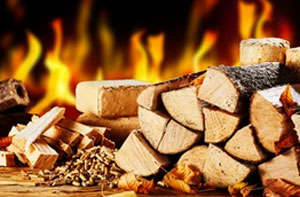
When you're looking for firewood and logs in Barton-upon-Humber, contacting your local tree surgeon is always a good idea, because they tend to be an excellent source for this. This is no great surprise, as tree surgeons spend the majority of their days chopping down trees and branches.
Some tree surgeons in and around Barton-upon-Humber may be willing to give you branches and logs cost-free, as they've always got an excess of them to dispose of, while others will require paying for seasoned and chopped logs which are fully dried out and ready to burn.
The perfect logs to burn on your log burning stove or open fire will have a moisture content of below 20 percent, and will have been left to dry out for at least 12 months. The advantage of getting logs from tree surgeons, is that these are most likely to be assorted hardwood logs, which will throw out heat for three or four hours, giving a sustained burn. Softwood logs are great for starting a fire, so if you can get your hands on a few of these as well, that is going to be useful.
Coming Soon: Tree pruning Barton-upon-Humber.
Tree Surgery Tasks Barton-upon-Humber

Barton-upon-Humber tree surgeons will likely help you with formative pruning, tree pruning, drop crotching, stump treatment Barton-upon-Humber, site clearance, crown removal, tree fertilising in Barton-upon-Humber, professional tree care, terravention in Barton-upon-Humber, hedge lowering, cable bracing, woodland management, root removal Barton-upon-Humber, dead wooding, crown cleaning Barton-upon-Humber, tree reshaping, tree cutting, tree staking, shielding trees from grazing animals Barton-upon-Humber, emergency tree removal, crown lifting, removal of storm damaged trees, root flare exposure, tree removal, dead-wooding Barton-upon-Humber, waste removal, hedge cutting in Barton-upon-Humber, arboriculture, landscape clearing in Barton-upon-Humber, eco plug treatments in Barton-upon-Humber, commercial tree surgery Barton-upon-Humber, root grinding in Barton-upon-Humber, tree topping, tree bracing, woodchipping Barton-upon-Humber and other tree surgeon services in Barton-upon-Humber, Lincolnshire. Listed are just an example of the tasks that are accomplished by a tree surgeon. Barton-upon-Humber companies will let you know their full range of services.
Obtaining Guidance and Help
To ensure you hire a tree surgeon who is both up to the job and who'll not inflict irreparable damage on your precious trees, there are some questions that you should ask when looking for a tree surgeon in Barton-upon-Humber. Pertinent questions ought to be along the lines of: Are you able to give me references from past customers? Do you and your team have the appropriate certifications and qualifications (for tree management and chainsaw use)? Have you got employers and public liability insurance? Are you a member of a reputable professional association (such as The Arboricultural Association or the International Society of Arboriculture)? Do your working practices follow the British Standard? Can you provide me with a written quote? If your tree surgeon does not provide you with positive responses to any of these questions, look elsewhere.

You'll use a directory of qualified tree surgeons in the UK on the AA (Arboricultural Association) site, and also plenty of useful advice concerning how to choose a reliable tree surgeon. Another website offering a "find an arborist" tool and a "verify tree surgeon's credentials" tool, is the International Society of Arboriculture (ISA), where there is naturally a lot more information about tree management and surgery. You're also able to read loads of information about tree surgery as a profession by visiting the Wikipedia "Arborist" section here. To avoid wasting time and energy you can also try one of the well known trade portals such as Rated People or Trustatrader, where reviews are available to study and credentials have already been corroborated. A Government financed organisation where you can also locate genuine contractors including tree surgeons, comes in the shape of Trustmark.
Tree Surgeons Near Barton-upon-Humber: Also find: Barnetby-le-Wold tree surgeons, Barrow-upon-Humber tree surgeons, Burton upon Strather tree surgeons, South Killingholme tree surgeons, Hessle tree surgeons, Ulceby tree surgeons, Appleby tree surgeons, Goxhill tree surgeons, South Ferriby tree surgeons, Immingham tree surgeons, Winterton tree surgeons, Winteringham here. All of these locations are serviced by a local tree surgeon. Barton-upon-Humber residents can get tree surgery quotations by clicking here.
Lincolnshire Tree Surgeons
In Lincolnshire you can also get: North Kelsey tree management, Barrow Upon Humber tree care services, Louth tree care, Cranwell tree surgery, West Butterwick tree surgeon, Manby tree surgery, Owston Ferry tree care, Healing tree care, Donington tree surgeons, Westwoodside tree surgeons, Nocton tree surgeon, Scotter tree surgeon, Belton tree care, Navenby tree care, Sutterton tree surgery, Gainsborough tree surgeons, Barrowby tree surgeon, Haxey tree care services, Moulton Chapel tree management, Messingham tree care services, Haddington tree care services, Ropsley tree management, Woodhall Spa tree surgeons, Dunston tree care services, North Thoresby tree care services, South Hykeham tree care services, Spalding tree surgeon, Barnetby le Wold tree surgery, Navenby tree care services. Throughout the Lincolnshire region you'll be able to track down tree surgeons who will offer you various services for your tree care needs. If you're unable to identify a satisfactory tree surgeon in Barton-upon-Humber itself you should not have any issues locating one close by.
Tree Care Services Barton-upon-Humber
- Barton-upon-Humber Air-Spading
- Barton-upon-Humber Tree Replanting
- Barton-upon-Humber Root Grinding
- Barton-upon-Humber Wood Chipping
- Barton-upon-Humber Crown Thinning
- Barton-upon-Humber Tree Lopping
- Barton-upon-Humber Tree Management
- Barton-upon-Humber Stump Treatment
- Barton-upon-Humber Arboriculture
- Barton-upon-Humber Crown Reduction
- Barton-upon-Humber Tree Pruning
- Barton-upon-Humber Tree Surveys
- Barton-upon-Humber Root Removal
- Barton-upon-Humber Woodchipping
Tree Surgeons Around Barton-upon-Humber: Over the last few months, homeowners in the following Barton-upon-Humber roads have requested price quotes for tree surgery: Stowgarth, Plover Court, Tofts Road, Nicholas Court, Loyalty Lane, St Peter's Court, Ardent Road, Holydyke, Far Ings Road, West Grove, Curtis Close, Prince Philip Drive, Vagarth Close, Beretun Green, Warblers Close, Stable Lane, Finchley Close, Ravendale, Priestgate, Glebe Way, Marsh Lane, Antelope Road, Ropery Lane, Overton Court, St. Peters Orchard, Ramsden Avenue, Church View, High Street, Caistor Road, and in these nearby postcodes DN18 5NR, DN18 5HB, DN18 5PL, DN18 5AS, DN18 5FQ, DN18 5DG, DN18 5AT, DN18 5DH, DN18 5EU, DN18 5BY. Work was accomplished in these places by a qualified tree surgeon. Barton-upon-Humber home and business owners benefited from high quality and competent tree surgery services in all cases.
More Barton-upon-Humber Trades: Not surprisingly, when you are having tree care carried out in Barton-upon-Humber, Lincolnshire, you are likely to need other garden related services, and aside from a tree surgeon in Barton-upon-Humber, Lincolnshire, you could additionally need block paving in Barton-upon-Humber, weeding in Barton-upon-Humber, hedge shaping in Barton-upon-Humber, landscaping in Barton-upon-Humber, garden pond builders in Barton-upon-Humber, garden design in Barton-upon-Humber, grass cutting services in Barton-upon-Humber, garden sheds in Barton-upon-Humber, artificial grass installers in Barton-upon-Humber, waste removal in Barton-upon-Humber, decking fitters in Barton-upon-Humber, garden wall construction in Barton-upon-Humber, garden clearance in Barton-upon-Humber, patio installation in Barton-upon-Humber, fence fitters in Barton-upon-Humber, local SKIP HIRE in Barton-upon-Humber, and other different Barton-upon-Humber tradespeople.
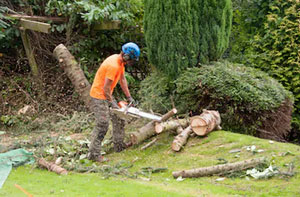 Tree Surgeon Barton-upon-Humber
Tree Surgeon Barton-upon-Humber Tree Surgeons Barton-upon-Humber
Tree Surgeons Barton-upon-Humber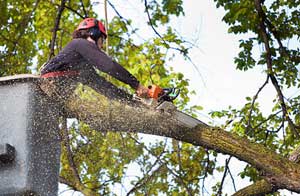 Tree Surgery Barton-upon-Humber
Tree Surgery Barton-upon-HumberMore Lincolnshire Tree Surgeons: Lincolnshire tree surgeons: Gainsborough, Crowle, Grimsby, Louth, Broughton, Spilsby, Bourne, Lincoln, Spalding, Horncastle, Alford, Skegness, Holbeach, Caistor, Crowland, Boston, Market Deeping, Waltham, Winterton, Kirton in Lindsey, Grantham, Brigg, Bottesford, Barton-upon-Humber, Market Rasen, Cleethorpes, Epworth, North Hykeham, Stamford, Immingham, Burgh le Marsh, Pinchbeck, Long Sutton, Ruskington, Mablethorpe, Sleaford, Waddington and Scunthorpe.
Tree Surgeon Jobs Barton-upon-Humber: Find Barton-upon-Humber tree surgeon jobs here: Barton-upon-Humber Tree Surgeon Jobs
For the best local info relating to Barton-upon-Humber, Lincolnshire go here
Tree Surgery DN18 area, and dialling code 01652.
TOP - Tree Surgeon Barton-upon-Humber
More Trades: Gate Fitters - Gutter Cleaning - Tilers - Carpet Fitters - Carpenters
Tree Surgeon Near Me - Tree Felling Barton-upon-Humber - Tree Care Barton-upon-Humber - Tree Management Barton-upon-Humber - Woodland Management Barton-upon-Humber - Vegetation Management Barton-upon-Humber - Tree Surgeon Barton-upon-Humber - Stump Removal Barton-upon-Humber - Tree Surgeons Barton-upon-Humber




